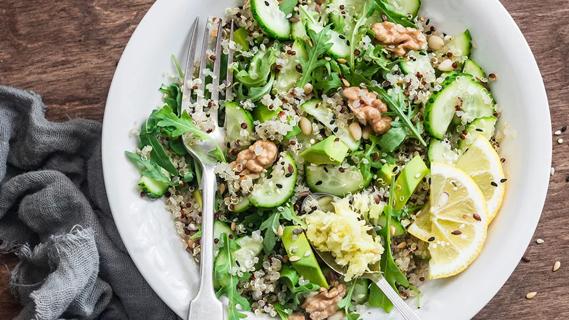The autoimmune protocol diet is designed to help identify inflammatory triggers

No one likes an unsolved mystery. When an issue surfaces and we don’t know exactly what’s causing it, we tend to sift through our options until we find the responsible source.
Advertisement
Cleveland Clinic is a non-profit academic medical center. Advertising on our site helps support our mission. We do not endorse non-Cleveland Clinic products or services. Policy
The autoimmune protocol (AIP) diet does just that for anyone who has a chronic autoimmune disease: It eliminates all possible food-based triggers for inflammation and slowly reintroduces them back into your diet until you find the ones you no longer need in your life.
Registered dietitian David Gardinier, RD, LD, explains just how the AIP diet can help reduce inflammation, which foods you can have and which foods you should avoid.
Like the paleo diet, the AIP diet is an elimination diet designed to cut out and replace certain foods known for being inflammatory triggers with nutrient dense foods to improve gut health, hormone regulation and immune system regulation. It’s perhaps most helpful for people who have chronic inflammation or autoimmune disorders like:
People who have autoimmune disorders tend to experience a variety of symptoms associated with inflammation that include headaches, fatigue, gastrointestinal upset, aches and pains (including muscle pain and joint pain), difficulty sleeping and changes to their skin health.
Advertisement
And while autoimmune disorders can have a variety of causes behind them, some research suggests your body may have an increased inflammatory response when you eat certain foods because of the gradual erosion of the intestinal barriers in your digestive system over time and what’s called a “leaky gut”.
“We know people with chronic autoimmune disorders often have higher levels of inflammation. So, the goal of this diet is to choose anti-inflammatory foods and foods that are going to promote gut health to minimize symptoms for people who have these chronic conditions,” says Gardinier.
The AIP diet works in three phases, with each phase focused on taking inventory of the foods you’re eating and the symptoms you experience after eating those foods or removing those foods from your daily consumption.
On the surface, the AIP diet can seem like a lot to sort through, which is why Gardinier stresses the importance of working with a dietitian before starting this diet on your own. One person’s body might not have the same inflammatory triggers as someone else’s, and cutting out foods means you have to really focus on diversifying the food you’re eating in an effort to get the amount of nutrition your body needs to remain healthy and strong.
“Like with any elimination diet, you’re taking out a lot of different foods and that puts you at risk for vitamin and mineral deficiencies if you’re not careful,” cautions Gardinier. “It’s really helpful to do this kind of diet alongside a registered dietitian who can help walk you through different recipes and make sure you’re getting a balanced diet with a lot of variety.”
When going through the following three phases, it could also be helpful to keep a food diary to track the kinds of foods you’re eliminating, the kinds of foods you’re re-introducing and the kinds of symptoms you experience, along with the level of their severity. Doing this can help you zero in on exactly which foods prove to be problematic and which foods are fine to keep around long term.
The first phase of the AIP diet can last from four to six weeks and up to a few months. During this phase, you eliminate certain foods, additives and medications believed to cause intestinal inflammation, an imbalance in your gut microbiota or worsen an immune system response. Some of the foods you eliminate during this phase include:
Advertisement
You also want to eliminate the use of tobacco and nonsteroidal anti-inflammatory medications (NSAIDs).
“It certainly feels like a lot at first glance, but looking at it, I think it’s important to focus on the foods you can include,” encourages Gardinier.
You can have vegetables, fruits, fish, grass-fed meats, organ meats (like liver) and poultry — and you can find pretty good alternatives to some of the foods you might be missing most.
“For grains and pasta products, you can make pasta replacements out of a lot of vegetables, like using cauliflower to replace rice,” suggests Gardinier. “You can also use honey to replace any of those processed sugars like high fructose corn syrup or sugar when you’re baking things.”
When eliminating these foods, you should cut them out of your diet all at once. Then, over the course of the next four to six weeks, monitor your chronic inflammatory symptoms closely.
“The goal is for people to start feeling better during this elimination phase,” says Gardinier. “If the AIP diet is working, people tend to have overall improvements in their quality of life and they’ll experience less symptoms the longer they’ve eliminated some of these foods.”
If by the end of this period, you haven’t experienced an improvement in your symptoms, it might be good to check-in with your dietitian to see if there are any other solutions or strategies you can try.
Advertisement
The second phase of the AIP diet can begin when you’ve experienced significant improvement in your symptoms.
“Ideally, you want to meet with your dietitian before starting the diet to go over everything, and you want to do a check-in about four to six weeks in to make sure you are feeling better. If that is the case, we’ll talk about the reintroduction phase at that second appointment,” explains Gardinier.
During this phase, you start to reintroduce the foods you’ve eliminated during the first phase back into your diet. You do this one at a time for a period of five to seven days before reintroducing the next food. The goal is to identify which of these foods contribute to your symptoms so you can continue to avoid eating those foods and reintroduce all of the foods that don’t cause any symptoms.
You can do this in one of two ways:
“It’s not a perfect science,” notes Gardinier. “It’s really about what you have found and thought would be best, and what symptoms you experience along the way.”
When reintroducing foods, you want to follow these steps:
Advertisement
Keep in mind that you should monitor your symptoms every step of the way. The importance of waiting up to one week after testing each food is because it could take some time for your body to develop a reaction. You can also develop a food intolerance over time, which means if you do have a reaction, you may want to re-try the same food after a year or so of avoiding it to see if your body has the same level of response.
“There is no set amount of time for this phase and it can take some time for your body or gut to heal,” says Gardinier. “When reintroducing foods, you also want to make sure there aren’t any outside stressors going on (like a cold or infection or lack of sleep) if you experience symptoms. If there is, try the food again the following week to see if you have the same reaction without those added stressors.”
This final phase of the AIP diet takes everything you’ve learned from the first two phases and combines them into a long-term maintenance plan. During this phase, there’s an emphasis on personalization and an increased focus on food diversity and diet flexibility. For example, certain foods might be triggering unwanted symptoms for you, so you’ll want to continue avoiding those foods in the long term (whereas someone else might not need to avoid those foods). And in some ways, you may be able to have some of those foods in small amounts under circumstances that feel right for you.
“During this phase, going off of the diet while traveling and during special events is encouraged, especially for the people who only have mild to moderate symptoms with trigger foods they’ve identified,” notes Gardinier. “But if it’s really affecting your day-to-day and your ability to do things that you want to do, it might not be worth revisiting those foods. What you do with the knowledge you’ve gained is up to you.”
It’s also up to you to decide how liberal you want to be with your diet and how much you want to impose those self-restrictions. But it’s possible to sustain a new approach to the foods you eat and avoid for the long term if it helps reduce the likelihood and severity for autoimmune reactions.
Examples of foods you should eliminate on the AIP diet include:
Examples of foods you can eat while on the AIP diet include:
If you have an autoimmune disorder or chronic inflammation and other forms of treatment haven’t proven as successful as you’d hoped, trying the AIP diet may be beneficial. Talk to your healthcare provider or a dietitian about starting the AIP diet and mention any questions or concerns you have about keeping up with the necessary amount of diverse foods and nutrition you need on a daily basis. Together, you can find ways to make sure the foods you eat aren’t having any adverse effects on your daily life.
Learn more about our editorial process.
Advertisement

It can take time for doctors to find a diagnosis

A satisfying veggie option with a kick

There are better breakfast options, but if it’s got to be cereal, look for whole grains, high fiber and no added sugar

These typically colorful plant-based substances provide various health benefits that help protect you from disease

If the flakes are undisturbed, pristine white and come from the top layer, it’s typically safe to indulge in a scoop

Snacking can bring benefits with healthy food choices and planning

It has nutrients your body needs, but it also comes with some serious health risks

Ground flaxseed is full of heart-healthy omega-3s, antioxidants and fiber, and easy to add to just about any recipe

Type 2 diabetes isn’t inevitable with these dietary changes

Applying a hot or cold compress can help with pain